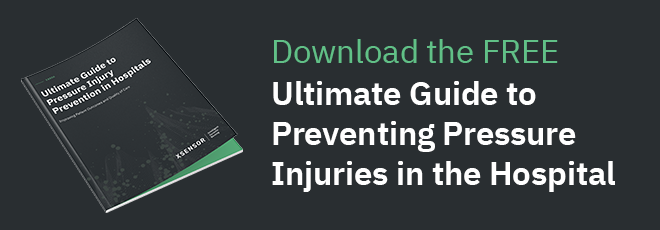
Solutions and Equipment for Relieving Pressure Sores
For health teams working to prevent and manage pressure sores, these solutions and equipment are both effective and efficient.
Medical professionals working in health care institutions worldwide understand the significance of pressure injuries, and the drain on resources they often create. Pressure injuries—also known as pressure sores, bedsores and pressure ulcers—present challenges for both staff and patients.
The United States alone sees 2.5 million pressure injuries develop every year, with 60,000 of those resulting in death. Once developed, pressure sores require significant hands-on care and institutional resources, and in a world of urgent, evolving medical needs, these preventable pressure injuries can negatively affect an institution’s efficiency and patient care.
Fortunately, effective solutions and equipment exist to both mitigate injury development and manage wounds among hospital patients. Alongside proper wound care protocols and holistic treatment plans, pressure sensing technology platforms present significant advantages to hospitals seeking to provide better patient care across the board, while successfully optimizing staff workloads.
Pressure Sores: The 4 Stages of Development
Pressure ulcer progression has been classified into four main stages of injury to the skin. Any injury—whether early or advanced in development—must be treated with urgency, using strategies and technology that prevent the sore from advancing quickly.
Here are the four stages and the types of pressure sores, from early skin damage to serious ulcer progression.
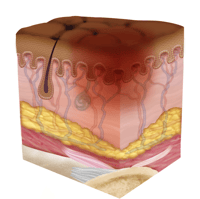 Stage 1 Pressure Injuries and Ulcers: Early on in pressure ulcer development, the skin is developing injury. While no open sores or broken skin is present yet, skin may appear redder, warmer or firmer than usual. Known as a non-blanchable erythema of intact skin, the color change may even indicate the beginnings of a serious injury to the deep tissue.
Stage 1 Pressure Injuries and Ulcers: Early on in pressure ulcer development, the skin is developing injury. While no open sores or broken skin is present yet, skin may appear redder, warmer or firmer than usual. Known as a non-blanchable erythema of intact skin, the color change may even indicate the beginnings of a serious injury to the deep tissue.
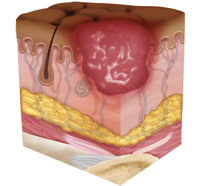 Stage 2 Pressure Injuries and Ulcers: Stage 2 pressure sore development is where the true sore, or ulcer, develops as a break in the skin. This is often very painful, and can create serious damage within the skin. Known as partial-thickness skin loss with exposed dermis, these bed wounds can quickly become something worse.
Stage 2 Pressure Injuries and Ulcers: Stage 2 pressure sore development is where the true sore, or ulcer, develops as a break in the skin. This is often very painful, and can create serious damage within the skin. Known as partial-thickness skin loss with exposed dermis, these bed wounds can quickly become something worse.
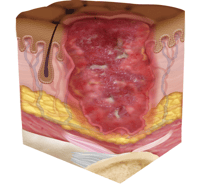 Stage 3 Pressure Injuries and Ulcers: In this stage, the pressure ulcer has developed into the soft tissue underneath the skin. Known as full-thickness skin loss, this pressure sore stage may showcase a deep wound, especially in an area with more adipose tissue.
Stage 3 Pressure Injuries and Ulcers: In this stage, the pressure ulcer has developed into the soft tissue underneath the skin. Known as full-thickness skin loss, this pressure sore stage may showcase a deep wound, especially in an area with more adipose tissue.
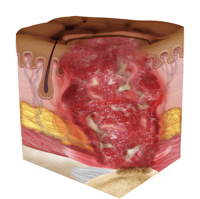 Stage 4 Pressure Injuries and Ulcers: By the final and most serious stage of a pressure sore, the skin may have receded into the muscle tissue or the bone, causing lasting damage to the skin and underlying areas. Known as full-thickness skin and tissue loss, this pressure sore stage can mean visible or palpable fascia, bone, muscle or tendon.
Stage 4 Pressure Injuries and Ulcers: By the final and most serious stage of a pressure sore, the skin may have receded into the muscle tissue or the bone, causing lasting damage to the skin and underlying areas. Known as full-thickness skin and tissue loss, this pressure sore stage can mean visible or palpable fascia, bone, muscle or tendon.
Preventing Pressure Sores During Hospital Stays
Several kinds of health care equipment and technology exist to help hospitals reduce the risk of pressure injuries and relieve them once acquired. A study from the National Clinical Guideline Centre places these solutions into three main categories: low-tech, continuous low-pressure support surfaces; high-tech support surfaces; and other support surfaces. These are separate from foundational pressure injury mitigation practices including patient turn schedules and head-to-toe screening.
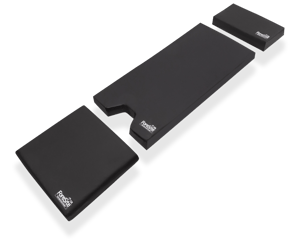 Equipment to Relieve Pressure Sores
Equipment to Relieve Pressure Sores
Low-tech, continuous low-pressure support surfaces involve items like mattress pads, alternative mattresses and other materials that help to relieve pressure on the skin and lower the risk of developing pressure ulcers.
High-tech support surfaces for preventing pressure sores may include air-fluidized beds, beds with sensing technology, and mattresses or overlays that alternate pressure to redistribute pressure automatically. XSENSOR’s dynamic sensing technology falls into this category, using high-tech support to prevent and manage pressure sores at every stage.
Hospital administration may also choose to implement other support surfaces, such as positioning devices underneath the knees, ankles, calves, lower back, elbows and heels—or other vulnerable areas—for high-risk patients to reduce the risk of shear forces. These support surfaces provide an easy yet optimal method to protect bony prominences and reduce friction and shear wherever possible. They may also include advanced surfaces for operating tables.
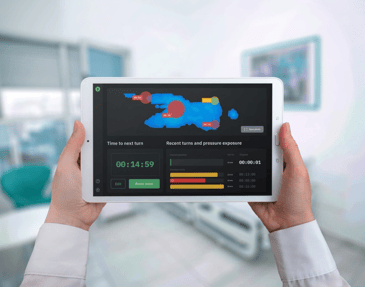 XSENSOR’s Pressure Injury Solution Technology
XSENSOR’s Pressure Injury Solution Technology
Health care professionals can rely on XSENSOR for technology solutions that both prevent pressure injuries and aid in their treatment.
From hospital beds to surgical tables to wheelchair seating, our technology combines medical expertise with dynamic sensing technology that allows for continuous pressure monitoring. Our solutions elevate patient care while helping lower hospital staff workloads.
- For hospital beds: Our unique ForeSite Intelligent Surface mattress system uses more than 1500 sensor cells on the surface of a mattress or fitted cover to measure patient body surface pressures, displaying data in real time for continuous monitoring. The system includes a turn clock to track repositioning and informs better patient care. Powered by AI, our support surfaces use technology that helps redistribute pressure and allows tissues to reoxygenate.
- For surgical tables: Our ForeSite OR system carries the same technology through to the operating room, which is excellent for ensuring safe positioning and managing risk in longer surgeries. ForeSite OR's integrated sensing layer helps clinicians redistribute pressure to support skin and reduce risk.
- For wheelchairs: Our ForeSite SS system utilizes high resolution sensing for those in wheelchairs. Since wheelchair patients can be very susceptible to tissue damage, the ForeSite SS system uses sensing, high-resolution images and software to show clinicians the necessary data.
XSENSOR’s dynamic sensing technology offers a complete solution for clinicians and healthcare professionals looking to improve patient care with effective pressure ulcer prevention and treatment.
Our meticulous design and industry-leading technology allows for continual pressure monitoring and real-time data sharing, empowering clinicians to make properly-informed decisions for everyone involved.
Preventing and managing pressure injuries places strain on both staff and patients; integrating XSENSOR’s dynamic sensing technology into your protocols will equip you to provide care where it’s needed—but not where it isn’t—improving efficiency and standards of care across your entire institution.
Pressure injury schematic drawings courtesy of The National Pressure Injury Advisory Panel. https://npiap.com/page/PressureInjuryStages

